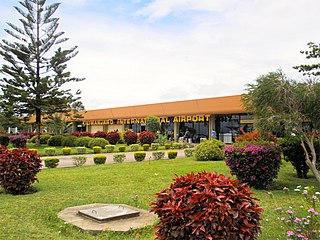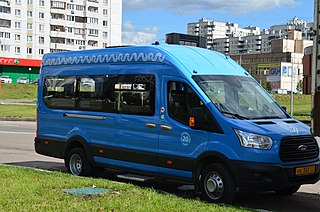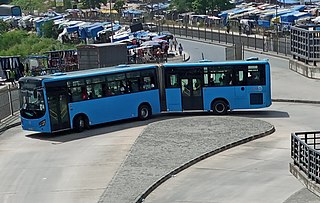
Dar es Salaam or commonly known as Dar, is the largest city and financial hub of Tanzania. It is also the capital of Dar es Salaam Region. With a population of over six million people, Dar is the largest city in East Africa and the seventh-largest in Africa. Located on the Swahili coast, Dar es Salaam is an important economic centre and is one of the fastest-growing cities in the world.

The transport system in Rwanda centres primarily around the road network. Paved roads lie between the capital, Kigali, and most other major cities and towns in the country. Rwanda is also linked by road with other countries in the African Great Lakes, via which the majority of the country's imports and exports are made.
Transport in Tanzania includes road, rail, air and maritime networks. The road network is 86,472 kilometres (53,731 mi) long, of which 12,786 kilometres (7,945 mi) is classified as trunk road and 21,105 kilometres (13,114 mi) as regional road. The rail network consists of 3,682 kilometres (2,288 mi) of track. Commuter rail service is in Dar es Salaam only. There are 28 airports, with Julius Nyerere International being the largest and the busiest. Ferries connect Mainland Tanzania with the islands of Zanzibar. Several other ferries are active on the countries' rivers and lakes.

Zanzibar is an insular semi-autonomous province which united with Tanganyika in 1964 to form the United Republic of Tanzania. It is an archipelago in the Indian Ocean, 25–50 km (16–31 mi) off the coast of the African mainland, and consists of many small islands and two large ones: Unguja and Pemba Island. The capital is Zanzibar City, located on the island of Unguja. Its historic centre, Stone Town, is a World Heritage Site.

Kilimanjaro International Airport (KIA) (IATA: JRO, ICAO: HTKJ) is an international airport located in Hai District, Kilimanjaro Region, Tanzania. The airport serves the cities of Arusha and Moshi. The airport handled 802,731 passengers in 2014 and mainly serves regional flights as well as a few long-haul services due to its importance as a leisure destination. It is the largest airport in northern Tanzania, by size and passenger volume.

A share taxi is a mode of transport which falls between a taxicab and a bus. These vehicles for hire are typically smaller than buses and usually take passengers on a fixed or semi-fixed route without timetables, but instead departing when all seats are filled. They may stop anywhere to pick up or drop off their passengers. Often found in developing countries, the vehicles used as share taxis range from four-seat cars to minibuses. They are often owner-operated.

Kariakoo is a ward in the Ilala District of Dar es Salaam, Tanzania. It has a population of 9,405 (2002). The name derives from a corruption of the British "Carrier Corps", that used to be based in this area. Today, Kariakoo is mainly known for its extensive market, that spans several city blocks.

A minibus, microbus, minicoach, or commuter is a passenger-carrying motor vehicle that is designed to carry more people than a multi-purpose vehicle or minivan, but fewer people than a full-size bus. In the United Kingdom, the word "minibus" is used to describe any full-sized passenger-carrying van or panel truck. Minibuses have a seating capacity of between 12 and 30 seats. Larger minibuses may be called midibuses. Minibuses are typically front engine step-in vehicles, although low floor minibuses are particularly common in Japan.

Morogoro is a city in the eastern part of Tanzania 196 kilometres (122 mi) west of Dar es Salaam. Morogoro is the capital of the Morogoro Region.
It is also known informally as "Mji kasoro bahari" which translates to “city short of an ocean/port." The Belgian based non-profit, APOPO trains Gambian pouched rats known as HeroRATS for landmine detection, and detection of tuberculosis in Morogoro. Morogoro lies at the base of the Uluguru Mountains and is a centre of agriculture in the region. The Sokoine University of Agriculture is based in the city. A number of missions are also located in the city, providing schools and hospitals. Morogoro is home to the Amani Centre, which has helped over 3,400 disabled people in the surrounding villages.

Marshrutka or marshrutnoe taksi or routed taxicab, are share taxis found in Eastern Europe and the republics of the former Soviet Union. Usually vans, they drive along set routes, depart only when all seats are filled, and may have higher fares than buses. Passengers can board a marshrutka anywhere along its route if there are seats available.

Dar es Salaam Region is one of Tanzania's 31 administrative regions and is located in the east coast of the country. The region covers an area of 1,393 km2 (538 sq mi). The region is comparable in size to the combined land and water areas of the nation state of Mauritius Dar es Salaam Region is bordered to the east by Indian Ocean and it is entirely surrounded by Pwani Region. The Pwani districts that border Dar es Salaam region are Bagamoyo District to the north, Kibaha Urban District to the west, Kisarawe District to the south west and Mkuranga District to the south of the region. The region's seat (capital) is located inside the ward of Ilala. The region is named after the city of Dar es Salaam itself. The region is home to Tanzania's major finance, administration and industries, thus the making it the country's richest region. According to the 2022 census, the region has a total population of 5,383,728 and national census of 2012 had 4,364,541. The region has the highest population in Tanzania followed by Mwanza Region.

In Ghana and neighboring countries, tro tro are privately owned minibus share taxis that travel fixed routes leaving when filled to capacity. While there are tro tro stations, these vehicles for hire can also be boarded anywhere along the route.

In Kenya matatu or matatus are privately owned minibuses used as share taxis. Often decorated, many matatu feature portraits of famous people or slogans and sayings. Likewise, the music they play is also aimed at quickly attracting riders. Over 70% of commuter trips are taken using matatu in cities like Nairobi.
East African Airways Corporation, more commonly known as East African Airways, was an airline jointly run by Kenya, Tanzania, and Uganda. It was set up on 1 January 1946, starting operations the same year. The airline was headquartered in the Sadler House in Nairobi, Kenya. The corporation was dissolved in 1977 amid deteriorated relations among the three countries.
The Tanzania FA Cup is the top knockout tournament of the Tanzanian football.

Tanzania Ports Authority (TPA) is a parastatal public corporation acting under the aegis of the Ministry of Infrastructure Development, that has the responsibility "to manage and operate" the ocean ports and lake ports of the country of Tanzania. The Tanzania Ports Authrorty headquarters are located in Kurasini Dar es Salaam. It is a member of the Port Management Association of Eastern and Southern Africa.

The Dar es Salaam commuter rail, informally known as Treni ya Mwakyembe, is an urban and suburban commuter rail network serving the Tanzanian commercial city of Dar es Salaam. It is one of the two initiatives taken by the government to ease travel within the congested city; the other being the Dar es Salaam bus rapid transit system. Services are provided by the Tanzania-Zambia Railway Authority (TAZARA) and Tanzania Railways Limited (TRL).

Dar es Salaam bus rapid transit is a bus rapid transit system that began operations on 10 May 2016 in Dar es Salaam, Tanzania. The transit system consists of 6 phases and the construction of the first phase began in April 2012 by the Austrian construction company Strabag International GmbH. Construction of the first phase was completed in December 2015 at a total cost of €134 million funded by the African Development Bank, World Bank and the Government of Tanzania. The first phase of the project has a total length of 21.1 kilometers with dedicated bus lanes on three trunk routes with a total of 29 stations. The first Phase of the system is operated by The Usafiri Dar es salaam Rapid Transit (UDA-RT) under the surveillance of the Land Transport regulatory authority (LATRA) Currently, the route is serviced by a fleet of 140 Chinese built Golden Dragon buses, providing express and local service for over 20 hours daily from 04:30 am to 12:00 midnight. In September 2022, BRT Fleet size had increased to 210.

The Port of Dar es Salaam is the principal port serving Tanzania. The port is one of three ocean ports in the country and handles over 90% of the country's cargo traffic. According to the International Association of Ports and Harbors, it is the fourth largest port on the African continent's Indian Ocean coastline after Durban, Mombasa and Maputo. The port acts as a gateway for commerce and trade for Tanzania and numerous bordering landlocked states.

In African cities, bus rapid transit is a relatively new phenomenon. The first system was opened in 2008 in Lagos, Nigeria and since then, many more BRT systems have been undertaken and are in different stages of development. 2016 saw a record three new BRTs on the continent. Ousmane Thiam, Honorary President of the International Association of Public Transport and President of CETUD, the urban transport authority in Dakar (Senegal), reckons there will be a significant development of BRT in Africa over the next years.



















